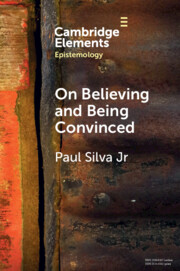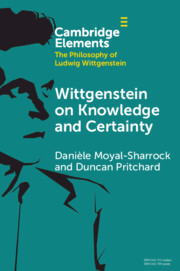Refine search
Actions for selected content:
45 results
Chapter 5 - Substantiating Suffering
-
- Book:
- Law and Torture
- Published online:
- 17 December 2025
- Print publication:
- 18 December 2025, pp 131-160
-
- Chapter
- Export citation
1 - Introduction to Decision Theory and Decision Making
- from Part I - Analytics: Probability, Evaluation, Decision Trees, and Strategies for Decision Making
-
- Book:
- Making Decisions: Analytics, Cognition, and Application
- Published online:
- 23 October 2025
- Print publication:
- 06 November 2025, pp 3-11
-
- Chapter
- Export citation
Chapter 3 - Knowledge Doesn’t Exist
-
- Book:
- Knowledge Doesn't Exist and Other Thoughts on Critical Thinking
- Published online:
- 22 October 2025
- Print publication:
- 21 August 2025, pp 32-45
-
- Chapter
- Export citation
3 - Is There a Legal A Priori?
- from Part I - Reinach and His Method
-
-
- Book:
- Reinach and the Foundations of Private Law
- Published online:
- 20 July 2025
- Print publication:
- 07 August 2025, pp 82-105
-
- Chapter
-
- You have access
- Open access
- HTML
- Export citation
8 - Religious Fundamentalism and Violent Extremism
- from Part II - Individual-Level Perspectives
-
-
- Book:
- The Cambridge Handbook of the Psychology of Violent Extremism
- Published online:
- 31 October 2025
- Print publication:
- 07 August 2025, pp 142-165
-
- Chapter
- Export citation
Introduction
-
- Book:
- Vico and the Maker's Knowledge Tradition
- Published online:
- 27 June 2025
- Print publication:
- 17 July 2025, pp 1-24
-
- Chapter
- Export citation
Chapter 22 - Conclusion
-
-
- Book:
- On Discovery
- Published online:
- 05 May 2025
- Print publication:
- 22 May 2025, pp 265-289
-
- Chapter
- Export citation

On Believing and Being Convinced
-
- Published online:
- 30 January 2025
- Print publication:
- 30 January 2025
-
- Element
- Export citation

Wittgenstein on Knowledge and Certainty
-
- Published online:
- 05 December 2024
- Print publication:
- 09 January 2025
-
- Element
- Export citation
13 - Facial Recognition Technologies in the Public Sector
- from Part II - Facial Recognition Technology across the Globe
-
-
- Book:
- The Cambridge Handbook of Facial Recognition in the Modern State
- Published online:
- 28 March 2024
- Print publication:
- 04 April 2024, pp 186-197
-
- Chapter
-
- You have access
- Open access
- HTML
- Export citation
4 - Development of the Scientific Method: From Papyrus to Petaflops
-
- Book:
- The Philosophy and Practice of Science
- Published online:
- 17 September 2023
- Print publication:
- 31 August 2023, pp 60-137
-
- Chapter
- Export citation
Attitude Strength: What’s New?
- Part of
-
- Journal:
- The Spanish Journal of Psychology / Volume 26 / 2023
- Published online by Cambridge University Press:
- 17 April 2023, e4
-
- Article
-
- You have access
- Open access
- HTML
- Export citation
5 - Original Sin and Justification
-
-
- Book:
- The Cambridge Companion to the Council of Trent
- Published online:
- 02 October 2023
- Print publication:
- 16 March 2023, pp 97-121
-
- Chapter
- Export citation
Social Doubt
-
- Journal:
- Journal of the American Philosophical Association / Volume 10 / Issue 1 / March 2024
- Published online by Cambridge University Press:
- 17 January 2023, pp. 46-63
-
- Article
-
- You have access
- Open access
- HTML
- Export citation
14 - Certainty requirements in the law of trusts
- from Part E - Express trusts
-
- Book:
- A Sourcebook on Equity and Trusts in Australia
- Published online:
- 14 December 2022
- Print publication:
- 19 December 2022, pp 365-386
-
- Chapter
- Export citation
3 - Agreements for Future Mediation
-
- Book:
- International Commercial Mediation
- Published online:
- 01 September 2022
- Print publication:
- 08 September 2022, pp 53-82
-
- Chapter
- Export citation
3 - Specific Kinds of Scientific Explanations
-
- Book:
- Understanding How Science Explains the World
- Published online:
- 17 June 2022
- Print publication:
- 07 July 2022, pp 29-42
-
- Chapter
- Export citation
8 - From Explanation to Knowledge
-
- Book:
- Understanding How Science Explains the World
- Published online:
- 17 June 2022
- Print publication:
- 07 July 2022, pp 86-101
-
- Chapter
- Export citation
6 - Explanatory Quality and Felt Understanding
-
- Book:
- Understanding How Science Explains the World
- Published online:
- 17 June 2022
- Print publication:
- 07 July 2022, pp 69-79
-
- Chapter
- Export citation
